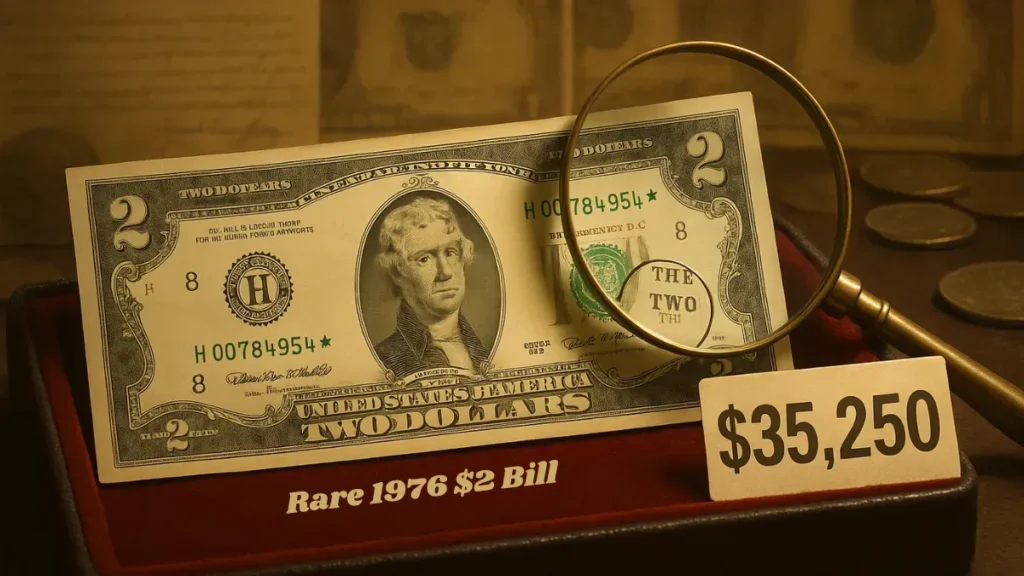Understanding the 1976 $2 Bill: History, Value, and What Makes It Special
The United States wasn’t always the independent nation it is today. Official independence came on July 4, 1776, with the signing of the Declaration of Independence. Over the years, America has faced challenges such as wars, economic struggles, and political changes that shaped its path.
Every year, citizens commemorate this with Independence Day festivities. But in 1976, the celebration was even more meaningful—it marked the country’s bicentennial. To honor this, the U.S. Treasury released a newly designed $2 bill.
What’s Unique About the 1976 $2 Bill?
The front of the 1976 $2 note still displays Thomas Jefferson, but the redesign on the back is what makes it memorable. The reverse features a detailed engraving of John Trumbull’s “Declaration of Independence,” capturing the moment the founding fathers presented the historic document.
What made these bills unusual is that many people didn’t use them. At the time, the country was experiencing a recession, and most people felt a $2 bill was too much to hang onto casually—much like carrying a $1,000 bill today. So, many simply saved them, adding to their collectible status.
A Bit of Background on the 1976 Series
In the early 1970s, Congress approved a new $2 bill to commemorate 200 years of U.S. independence. It was officially released to the public on July 5, 1976. Although the note carries a 1976 date, no additional printing took place until nearly two decades later in 1995.
Because many Americans saw it as a commemorative item rather than a piece of everyday currency, lots of these bills remained uncirculated. Their historical significance and well-preserved condition have made them enduring favorites among collectors of American currency.
How to Tell If a 1976 $2 Bill Is Valuable
Collectors assess value using several criteria. Here’s what to look for if you’re curious about your bill:
- Condition (Grade): Crisp, clean notes with no damage are worth more.
- Serial Numbers: Low numbers or repeating patterns can add value.
- Signatures: Notes signed by Arthur Burns and Robert B. Anderson are notable.
- Federal Reserve District: Bills from banks with fewer issues can be rarer.
- Star Notes: Look for a star (*) at the end of the serial number.
- Post Office Stamps: First-day issue stamps can make a bill more collectible.
A bill that ticks several of these boxes might be worth more than you think.
How Much Is a 1976 $2 Bill Worth?
The market value of these bills varies depending on a few key elements—chiefly, the note’s condition, rarity, and appeal to collectors. Here are some ballpark values:
- Heavily used bills: Around $5.
- Uncirculated Dallas notes (“K” district): Up to $9.90.
- Mint Kansas City (“J”) notes: As high as $16.50.
Even small variations in condition and features can significantly affect the selling price, especially on collector platforms and auctions.
Low-Priced Bills (Under $20)
This tier includes bills that have clearly been circulated. While still collectible, they are more accessible and affordable for beginners. Examples include:
- A well-worn 1976 $2 bill may be priced around $5.
- An uncirculated bill from the Dallas district might sell for roughly $9.90.
- A crisp Kansas City issue in great shape could bring in about $16.50.
These are perfect for entry-level collectors who want historical currency without breaking the bank.
Mid-Range Bills ($20–$500)
Bills in this price range often feature special elements that boost their value. Some characteristics that put them in this category include:
- Star Notes: A New York-issued star note can go for around $95.
- First-Day Stamped Bills: These can fetch prices close to $399.
- Autographed Notes: A Kansas City star note with an autograph has been valued at $257.
The mid-range market is ideal for collectors seeking pieces with unique features or moderate rarity without venturing into the top-tier pricing.
High-End Bills ($500–$2,500)
Premium bills often combine perfect condition with rare features. These are generally the kinds of collectibles that are auctioned or professionally graded. Examples include:
- An uncirculated star note with a notable autograph—worth around $850.
- A low serial number like “33”—nearly $2,000 in value.
- A set of two bills with consecutive serial numbers—often over $2,000.
High-grade, rare serial numbers or professionally authenticated notes can drive up prices in this range.
Top-Tier Collectibles ($2,500 and up)
These are the most desirable and limited items, often held by seasoned collectors or found in prestigious auctions. Examples include:
- A complete, uncirculated pack of 100 notes—valued at $3,450.
- A note with serial number “00000002”—sold for $9,400.
- A San Francisco serial “00000001” bill—fetched over $21,000.
- The only known star note with serial number 1 in private hands—brought $35,250.
These examples show how rare and well-documented features can send a bill’s value soaring into five figures.
FAQs About 1976 $2 Bills
How can I tell if mine is a star note?
Check the serial number—if it ends with a star symbol (*), it’s a rare replacement note.
Are there any printing errors to watch for?
Yes, misprints like offset printing, mismatched serial numbers, or missing parts of the design can be rare and valuable.
How do I know if my bill is real?
Look at the texture, color, and print clarity. Older bills may lack modern features, but should still have precise ink patterns and accurate serial formatting.
Final Thoughts
The 1976 $2 bill is more than a piece of money—it’s a symbolic artifact from a major moment in U.S. history. Whether you’re a beginner intrigued by its backstory or an expert searching for rare finds, this bill offers lasting appeal. There’s something for everyone, from well-used notes under $10 to serial-numbered rarities worth thousands. By learning what makes them special and being cautious of counterfeits, you can build a rewarding collection. Start with what you can afford and grow from there.
Happy collecting.

